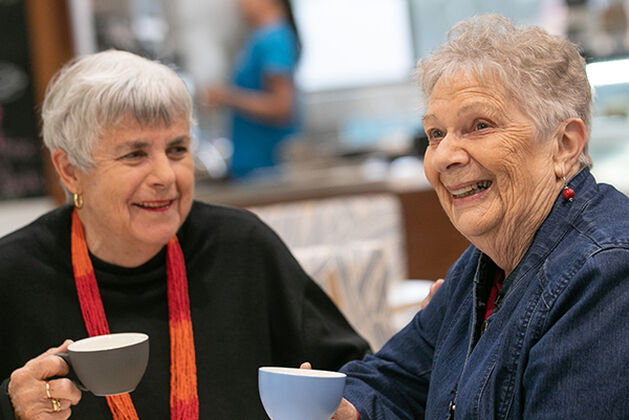Understanding your superannuation: How to fund a fulfilling retirement
Whilst the average age of retirement in Australia is 55, most pre-retirees are planning to work well into their sixties to access their pension and secure a more stable source of income.
Scroll to Explore

03 February 2025
Stories
| Retirement Living
Understanding your superannuation: How to fund a fulfilling retirement
There is no right or wrong way to retire, and just as the working population chooses careers that are varied and diverse, equally your retirement lifestyle will reflect your own unique interests, goals, and skills.
People choose to make the transition in a variety of ways. Some migrate slowly into retirement over several years while others count down the days and hours, taking the plunge as soon as they can.
The way you choose to fund your retirement usually plays a big part in these decisions. For many, the prospect of losing their employed regular income can be daunting, even if you’ve planned well for your retirement.
This article will walk you through the basics of how superannuation works once you retire, as well as detailing the latest updates to the Australian preservation age, and how you can best plan for a fulfilling retirement.
In this article
- How does superannuation work when you retire?
- Preservation age: What’s the earliest I can access my superannuation?
- Can I transition into retirement?
- The golden rule of retirement: Plan how you’ll spend your time.
How does superannuation work when you retire?
In Australia, there are two main sources of regular income that most people can depend upon once they leave the workforce: Superannuation, and the Age Pension.
Superannuation – this is money that your employer(s) has put aside for you during your working life, ready for you to live on once you retire. The fund may also include any additional contributions that you have made over the years.
Your “super” becomes accessible once you reach what is known as your “preservation age,” which is between 55-60, depending on your date of birth (jump to Preservation age: What’s the earliest I can access my superannuation?)
You must be retired to access the entire fund; however, some people choose to access portions of it before they stop working completely, transitioning into retirement over time – more on this later.
Age Pension – this is paid to you by the Australian Government, and in most cases, you must be over 67 years old to receive it.
To access the Age Pension, you usually need to have been an Australian resident for at least 10 years. For at least 5 of these years, there must have been no break in your residency.
The Age Pension is means tested, and the amount you receive will depend on:
your income
how much property you own
if you’re single or part of a couple.
You can find out about the current rates of the Age Pension here.
The way you choose to fund your retirement will depend on your personal circumstances and how you choose to transition out of the working world.
As with any major life change, it’s wise to seek professional advice to make the best financial decisions for your situation.
Preservation age: What’s the earliest I can access my superannuation?
Your preservation age is the earliest age that you can access your superannuation fund. This will be between 55 and 60, depending on when you were born (see table below), and you must be fully retired from work at this stage.
Regardless of your birth year, you can access your superannuation at age 65 - even if you are still working.
Your date of birth | Preservation age |
| Before 1 July 1960 | 55 |
| 1 July 1960 - 30 June 1961 | 56 |
| 1 July 1961 - 30 June 1962 | 57 |
| 1 July 1962 - 30 June 1963 | 58 |
| 1 July 1963 - 30 June 1964 | 59 |
| After 1 July 1964 | 60 |

Can I transition into retirement?
Yes. Once you reach your preservation age, you can choose to reduce your working hours and bolster your income with a regular payment from your superannuation. This is called a Transition to Retirement Income Stream (TRIS).
While you are working on a TRIS, your employer will still need to make compulsory contributions to your superannuation fund.
Want to learn more? Click here for a detailed guide on transitioning into retirement.
The golden rule of retirement: Plan how you’ll spend your time.
These days, most of us can confidently expect to live into our eighties, with the average life expectancy for men being 81, and 85 for women (ABS, 2021). And, with ongoing advancements in healthcare, this age is only set to become older over time.
In short, most of us can expect to be retired for at least two decades, if not three. It therefore makes good sense to plan how you’ll fill your days - having realistic goals and a new routine will give you a sense of purpose as you move into this new chapter of your life.
Retirees often talk about missing the social aspect of work life – the small, day-to-day interactions with peers. It’s important to find ways to recreate these in your retired life, too. Some people enjoy taking up new hobbies or volunteering in the community, but keeping up some form of regular social interaction with your community is crucial for your emotional wellbeing.
A wonderful way of doing this is to consider downsizing to a Retirement Village.
What is a retirement village?
Retirement villages – also known as retirement living or retirement communities – are becoming increasingly popular among retirees. They are aimed at those who are seeking an active, independent lifestyle among the community at a similar stage of life. They also have added benefits such as little to no maintenance costs, and the option to receive care in your own home if your health needs change over time.
Retirement villages are often home to beautiful, ‘resort-style’ facilities, such as swimming pools, cafes, and bowling greens, creating that village feel and a strong sense of community.
They are a wonderful option to consider when planning for retirement. Learn more about ‘village life’ and decide if it's for you.

How can I find a BaptistCare retirement village near me?
At BaptistCare, we’ve been providing quality, person-centred care for over 80 years across our retirement living communities in New South Wales, ACT, and Western Australia.
Discover the benefits of retirement living communities and easily find the nearest retirement community location that suits your lifestyle.
Click the link below to learn more about BaptistCare services:
Retirement villages are often home to beautiful facilities that the whole family can enjoy.